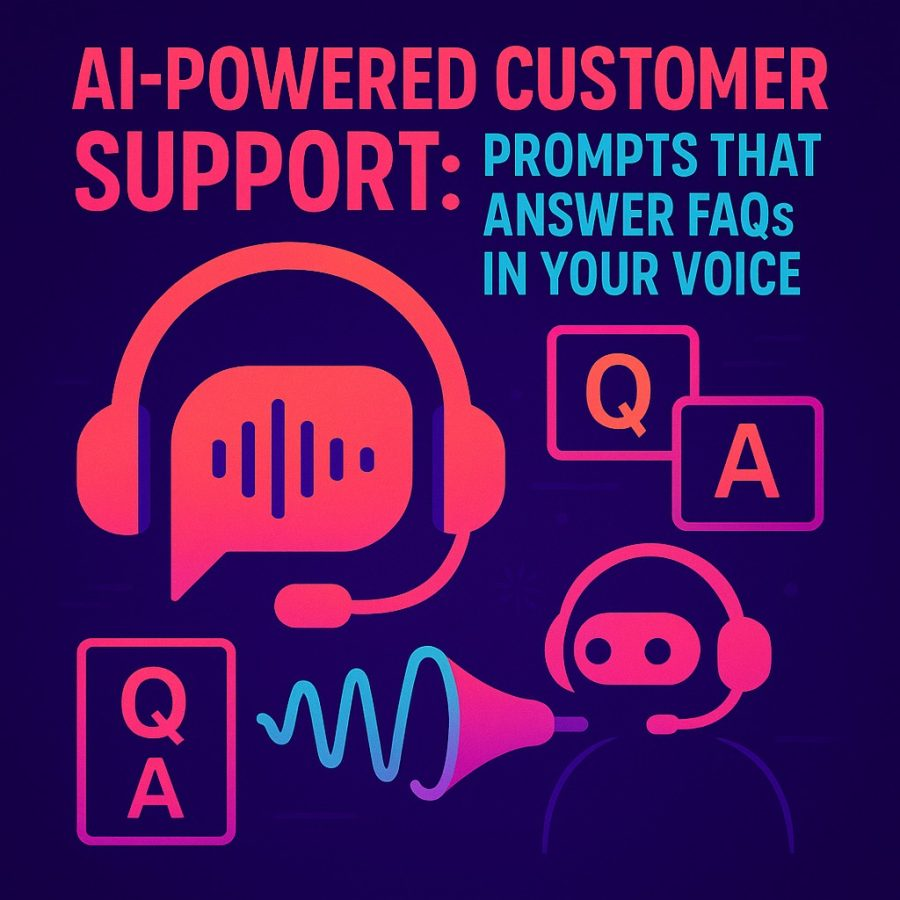Views: 0
Keeping up with customer questions can feel like an endless game of whack-a-mole. Common queries about shipping times, return policies, or account setup flood your inbox daily. Enter AI-powered customer support, a way to automate FAQ responses while staying true to your brand’s tone. By crafting thoughtful chatbot prompts, you can ensure every answer sounds like it came straight from your team minus the 24/7 staffing cost.
In this post, we’ll explore why customer support automation matters, how to develop AI customer service prompts that capture your unique voice, and best practices for rolling out an FAQ automation system that wins smiles and loyalty.
Why Embrace AI-Powered Customer Support?
- Scale Without Sacrifice
As your audience grows, manual replies become a bottleneck. Automating with AI ensures instant answers even during peak times so no question goes unanswered. - Consistent Brand Voice
Handing off routine FAQs to a chatbot trained on your tone guarantees every interaction feels personal and on-brand, whether a customer messages at 3 AM or 3 PM. - Cost Efficiency
Instead of hiring extra support reps, you invest once in prompt development and AI integration. That frees up budget for high-impact initiatives like product enhancements or VIP care. - Data-Driven Improvement
Analytics track which FAQs get triggered most and how customers rate responses. Use those insights to refine your AI customer service scripts and spot knowledge gaps.
Crafting Prompts That Truly Sound Like You
The secret to seamless FAQ automation isn’t fancy code; it’s the words you feed into your AI. Follow these steps to develop chatbot prompts that feel human and helpful:
- Define Your Brand Voice
Jot down three adjectives that describe your style: friendly, professional, witty, empathetic. Use these as guardrails for every prompt. - Gather Your Top FAQs
Audit support tickets and chat transcripts to list the ten most common questions. Prioritize clarity over cleverness simplicity builds trust. - Write a Prompt Template
For each FAQ, craft a user-query pattern and a response template.
- Pattern: “How long does shipping take?”
- Prompt:
“When a customer asks about delivery time, say: ‘We typically ship within 1–2 business days, and you’ll receive a tracking link shortly. If you need it faster, let us know!’ Use a warm, concise tone.”
- Incorporate Variables
Allow dynamic insertion of order numbers, product names, or names:
“If they mention order #1234, respond: ‘Hi [Name], your order #1234 is on its way tracking link is here: [Link]. Enjoy!’” - Test and Tweak
Run each prompt through your AI engine, then refine based on awkward phrasing or tone mismatches. Enlist colleagues to rate authenticity.
Example Prompts for Common Scenarios
- Returns & Refunds
“Customer: ‘How do I return an item?’
Bot Prompt: ‘Explain our 30-day return policy in a friendly way. Start with empathy like “We’re sorry it didn’t work out!” then outline steps: package, ship, and refund timeline.’” - Account Assistance
“Customer: ‘I can’t log into my account.’
Bot Prompt: ‘Offer troubleshooting: resetting password, clearing cache, or contacting support. Keep it reassuring: “No worries, let’s get you back in!”’” - Product Recommendations
“Customer: ‘Which model is best for beginners?’
Bot Prompt: ‘Compare Model A and Model B: focus on ease of use and price. Use bullet points and a casual “If I were you” style.’”
Integrating Automation into Your Workflow
- Choose the Right Platform
Popular options like ChatGPT, Zendesk’s AI, or Intercom let you plug in custom prompts and connect to your helpdesk. - Map Out the Customer Journey
Decide when to hand off to an agent. For example, after three unanswered follow-ups, escalate to live chat. - Train Your Team
Share prompt libraries and style guides so human agents match the AI’s tone when they step in. - Monitor Performance
Track metrics like deflection rate (questions resolved by AI) and customer satisfaction scores. Iterate prompts monthly.
Best Practices for Long-Term Success
- Keep Prompts Up to Date: Product lines and policies change. Schedule quarterly reviews to refresh responses.
- Balance Automation and Empathy: Use AI for routine questions, but maintain quick pathways to real people for complex issues.
- Leverage Analytics: Identify emerging FAQs and draft new prompts before ticket volume spikes.
- Personalize When Possible: Address customers by name and reference past interactions if your system allows.
Conclusion
Implementing AI-powered customer support doesn’t mean sacrificing the personal touch that makes your brand special. With carefully crafted prompts that answer FAQs in your voice, you can deliver instant, on-brand help while freeing up your team to tackle more nuanced challenges. Start by defining your tone, auditing top questions, and writing clear prompt templates. Then choose a platform, integrate into your support flow, and continually optimize based on data. The result? Faster resolutions, happier customers, and a scalable support system that grows with you.
Ready to revolutionize your helpdesk? Fire up your AI engine, draft those prompts, and watch your FAQ automation transform into a customer delight machine.


